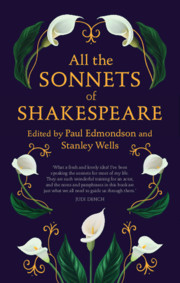Just started reading All the Sonnets of Shakespeare in PDF format, to be published by Cambridge University Press in September. Edited by Paul Edmondson and Stanley Wells, it shows how Shakespeare went about writing his famous 154 sonnets—when he wrote them and how he rewrote them. Can’t wait to get the book.
Instead of reading the sonnets in the numbered sequence of the 1609 quarto, which is the usual way, they examine them in what they believe was their order of composition. This puts a special focus on the considerable tinkering that went into them. They also show how Shakespeare incorporated sonnets, partial sonnets, and sonnet-writing into his plays. Their method yields lovely insights that bring us closer to the man himself and his development as a writer. Illustrating his sense of humor, for example, they cite this satirical incident in “Edward III” (now acknowledged as co-written by Shakespeare):
King Edward III (who is married) falls madly in love … with the virtuous (and also married) Countess of Salisbury as soon as he sees her. [He] is so visibly besotted that [he asks] his servant Lodowick to help him write a love sonnet to her. … Edward praises the Countess in extravagant, even comically hyperbolical terms, instructing Lodowick to call her ‘Better than beautiful’, to ‘Devise for fair a better word than fair’, saying that anything Lodowick may write is exceeded ‘Ten times ten thousand more’ by the value of the woman he is praising. Faced with such hyperbole, Lodowick bemusedly enquires ‘Write I to a woman?’, to which the King replies in exasperation ‘What think’st thou I did bid thee praise? A horse?’
Such a well-timed punchline! I laughed out loud.





